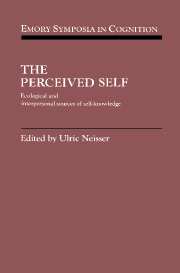1 - The self perceived
Published online by Cambridge University Press: 29 March 2010
Summary
This book brings new ideas to bear on an old problem. The old problem is that of self-knowledge and the self; the new ideas are based on analyses of ecological and social perception. James J. Gibson (1979) was the first theorist to insist that perceiving the self is an inevitable counterpart of perceiving the environment. Gibson's ideas are basic to the notion of an ecological self, which will be elaborated in this chapter. But the view of perception to be presented here is not simply ecological; it is social as well. Face-to-face interaction between individuals establishes a sense of an interpersonal self that is very different from anything the inanimate environment can offer. Both forms of self-perception appear very early in life, and both give rise to the experience of effective agency that is such an important component of self-awareness. They are the foundation on which other, more intellectual aspects of the self are built.
Because the term self has more than one meaning, it is best to begin with definitions. Distinctions among various kinds of self have been proposed for more than a century: William James's (1890) contrast between the “I” and the “me” was only the first of many such contrasts.
- Type
- Chapter
- Information
- The Perceived SelfEcological and Interpersonal Sources of Self Knowledge, pp. 3 - 22Publisher: Cambridge University PressPrint publication year: 1994
- 13
- Cited by



